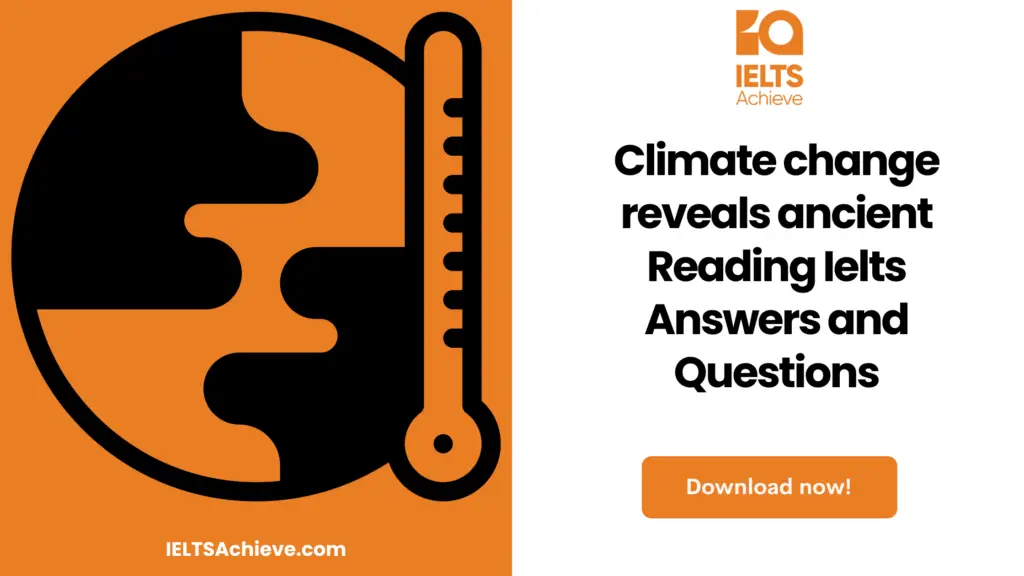The Blog post contains the following IELTS Reading Questions
- IELTS Reading Locating Information
- IELTS Reading Summary Completion
- IELTS Reading Multiple Choice Question
Stay informed and prepared for success – Explore our comprehensive Reading Test Info page to get valuable insights, exam format details, and expert tips for mastering the IELTS Reading section.
IELTS Reading Passage – Climate change reveals ancient

Climate Change Reveals Ancient Artefacts In Norway’s Glaciers
A. As the Earth’s climate warms, ancient ice fields are shrinking in Norway’s highest mountains, well above the treeline. As the ice has melted, it has been giving up the treasures it has kept safe for the past 6,000 years. These include things like arrows and skis from Viking Age traders. And these artifacts have given archaeologists some surprising insights into how ancient Norwegians made a living.
B. Archaeological sites don’t find a lot of natural things like textiles and hides. This is because they don’t last long if they aren’t protected from the microorganisms that cause decay. Extreme cold is a good way to keep artifacts relatively fresh for a few thousand years, but once they are thawed out, they start to break down pretty quickly. As ice cover melts around the world because of climate change, glacial archaeologists have to race against the clock to find new artifacts, keep them safe, and study them. If something fragile dries out and gets blown away by the wind, it might be lost to science very soon. On the other hand, if an arrow is exposed and then covered by snow, it might be well-preserved. Glacial archaeologists have to be very organized when they work in the field because they can’t predict what will happen.
C. A group of archaeologists, including Lars Pil of the Oppland County Council in Norway and James Barrett of the McDonald Institute for Archaeological Research, studied patches of ice in Oppland, which is in the middle of Norway and has some of the country’s highest mountains. Reindeer used to gather on these ice patches in the late summer to get away from biting insects, and since the late Stone Age, hunters have followed them. In addition, trade routes ran through the mountain passes of Oppland, connecting settlements in Norway to the rest of Europe. The slow but steady movement of glaciers tends to destroy anything at their bases, so the team focused on still patches of ice, mostly above 1,400 meters. That ice is found in fields of frost-weathered boulders, fallen rocks, and exposed bedrock that is covered by snow for nine months of the year. “Fieldwork is hard work—hiking with all our gear and often camping on permafrost—but very rewarding. Barrett says, “You’re saving the archaeology, bringing the melting ice to a wider audience, finding a unique environmental history, and really connecting with the natural environment.”
D. Archaeologists found more than 2,000 artifacts at the edges of the melting ice patches. These things told a story that went from 4,000 BCE to the beginning of the Renaissance in the 14th century. A lot of the objects have to do with hunting. Archers were easy to lose, and hunters often threw away broken bows rather than carrying them all the way home. Hunters going through the high mountain passes of Oppland could have used other things, too, like tools, skis, and horse tack.
E. Barrett and his team radiocarbon dated 153 of the artifacts and compared the results to the timing of major environmental changes in the region, such as cooling or warming periods, and major social and economic shifts, such as the growth of farming settlements and the spread of international trade networks leading up to the Viking Age. Many artifacts were discovered from certain historical periods, suggesting that human activity in the mountains was high at the time. However, during other times there were hardly any clues of life.
F. Barrett found the timing of these epochs to be particularly surprising. The mountains of Oppland are intimidating, and during times of extreme cold, glaciers can block the passages leading to the higher altitudes, making travel there nearly impossible. In the Late Antique Little lee Age, a brief period of deeper-than-usual cold that occurred about 536–600 CE, archaeologists speculated that humans would avoid living at higher altitudes. However, it became clear that hunters kept frequently travelling into the mountains despite the changing temperature, as evidenced by the quantity of items they reportedly discarded there.
“Remarkably, the findings from the ice may have remained through this period,” says Barrett. “This may show that the value of mountain hunting increased to complement poor agricultural harvests during times of low temperatures.” The increased reliance on hunting would have been necessary since widespread crop failures would have resulted from a colder turn in the Scandinavian climate.
G. The Viking Age began in the 700s and 900s CE, and many of the artifacts unearthed by Barrett’s crew date from that time period. During this time, trade routes connecting Scandinavia with Europe and the Middle East were growing. Even though ships are what first come to mind when discussing Scandinavian expansion, these new findings demonstrate the importance of terrestrial routes, such as the mountain passes of Oppland. Growing Norwegian cities and export markets would have increased the demand forhides for insulation and antlers for practical items like combs. Hunters must have been doing well.
H. A great deal of prehistoric and historic artifacts are still likely frozen in the mountains of Norway. Looking at the dates for their sample of 153 artifacts, Barrett’s team observed a period with absolutely no artifacts, around between 3,800 and 2,200 BCE. Indeed, such artifacts are quite uncommon in any part of Norway. Researchers speculate that this is because many of these artifacts have either dissolved or are still frozen in the ice. What this means is that in the future, as the ice melts, archaeologists may be able to retrieve some of these artifacts.
————— *Viking Age: a period of European history from around 700 CE to around 1050 CE when Scandinavian Vikings migrated throughout Europe by means of trade and warfare.————— **The Stone Age: a period in early history that began about 3.4 million years ago
Unlock your full potential in the IELTS Reading section – Visit our IELTS Reading Practice Question Answer page now!
Recommended Questions:
Renewable Energy IELTS Reading Question with Answer
Climate change reveals ancient reading questions
Questions 1—6
Reading Passage 2 has eight sections, A — H. Which section contains the following information?Write the correct letter, A-H, in boxes 1-6 on your answer sheet.
- Examples of items that would have been traded.
- A reference to the pressure archaeologists are under to work quickly.
- An explanation for weapons being left behind in the mountains.
- A reference to the physical difficulties involved in an archaeological expedition.
- An explanation of why less food may have been available.
- A reference to the possibility of future archaeological discoveries.
Questions 7—9
Complete the summary below.
Choose ONE WORD ONLY from the passage for each answer.
Write your answers in boxes 7-9 on your answer sheet.
Archaeological sites don’t find a lot of organic things like animal skins and clothes very often. They don’t have much protection against 7)________________ , so they break down pretty quickly. This isn’t always true, though. If the temperature is low enough, fragile artifacts can last for thousands of years.
A group of archaeologists has been working in the mountains of Norway’s Oppland to find artifacts that have been exposed by the melting ice. In the past, these mountains were used as trade routes, and 8)____________ would gather there in the summer to stay away from 9)_________ on lower ground. Archaeologists are interested in the things left behind by the people who lived in and used these mountains.
Questions 10—11
Choose TWO letters, A—E.
Write the correct letters in boxes 10 and 11 on your answer sheet.
Q) Which TWO of the following are true about the Viking Age, according to the author?
- Hunters at this time benefited from increased demand for goods.
- The beginning of the period saw the greatest growth in the wealth of Vikings.
- Vikings did not rely on ships alone to transport goods.
- Norwegian towns at this time attracted traders from around the world.
- Vikings were primarily interested in their trading links with the Middle East.
Questions 12—13
Choose TWO letters, A—E.
Write the correct letters in boxes 12 and 13 on your answer sheet.
Q) Which TWO of the following are TWO things that the writer says about what Barrett’s team found?
- The only things found in the higher mountain passes were skis and ski gear.
- Hunters would go into the mountains even when it was very cold.
- There weren’t that many artifacts from certain time periods.
- Some of the results from radiocarbon dating of artifacts were not reliable.
- In Oppland, more artifacts were found than anywhere else in the mountains.
Ready to improve your performance in Multiple Choice Questions (MCQs)? Click here to access our comprehensive guide on how to tackle MCQs effectively in the IELTS Reading section.
Unlock your full potential in the IELTS Reading section – Visit our IELTS Reading Practice Question Answer page now!
Recommended Questions:
Renewable Energy IELTS Reading Question with Answer
Climate change reveals ancient answers
1. G
2. B
3. D
4. C
5. F
6. H
7. Microorganisms/ micro-organisms
8. Reindeer
9. Insects
10. A
11. C
12. B
13. C

We hope you found this post useful in helping you to study for the IELTS Test. If you have any questions please let us know in the comments below or on the Facebook page.
The best way to keep up to date with posts like this is to like us on Facebook, then follow us on Instagram and Pinterest. If you need help preparing for the IELTS Test, join the IELTS Achieve Academy and see how we can assist you to achieve your desired band score. We offer an essay correction service, mock exams and online courses.

